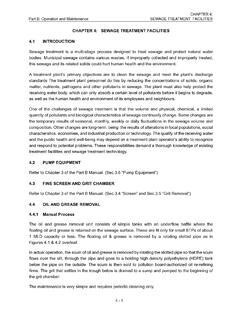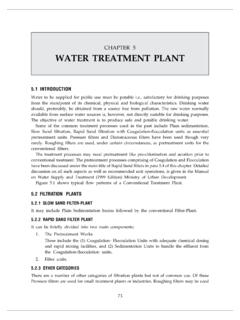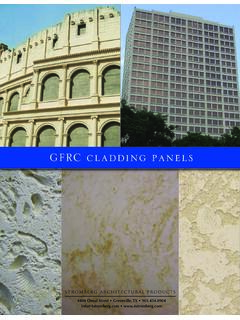Transcription of INDUSTRIAL SOLID WASTE
1 71 CHAPTER 6 INDUSTRIAL SOLID WASTE INTRODUCTION Environmental pollution is the major problem associated with rapid industrialisation, urbanisation and rise in living standards of people. For developing countries, industrialisation was must and still this activity very much demands to build self reliant and in uplifting nation s economy. However, industrialisation on the other hand has also caused serious problems relating to environmental pollution. Therefore, wastes seem to be a by-product of growth.
2 The country like India can ill-afford to lose them as sheer WASTE . On the other hand, with increasing demand for raw materials for INDUSTRIAL production, the non-renewable resources are dwindling day-by-day. Therefore, efforts are to be made for controlling pollution arising out of the disposal of wastes by conversion of these unwanted wastes into utilisable raw materials for various beneficial uses. The problems relating to disposal of INDUSTRIAL SOLID WASTE are associated with lack of infrastructural facilities and negligence of industries to take proper safeguards.
3 The large and medium industries located in identified (conforming) INDUSTRIAL areas still have some arrangements to dispose SOLID WASTE . However, the problem persist with small scale industries. In number of cities and towns, small scale industries find it easy to dispose WASTE here and there and it makes difficult for local bodies to collect such WASTE though it is not their responsibility. In some cities, INDUSTRIAL , residential and commercial areas are mixed and thus all WASTE gets intermingled.
4 Therefore, it becomes necessary that the local bodies along with State Pollution Control Board (SPCB) work out requisite strategy for organising proper collection and disposal of INDUSTRIAL SOLID WASTE . Management of INDUSTRIAL SOLID WASTE (ISW) is not the responsibility of local bodies. Industries generating SOLID WASTE have to manage such WASTE by themselves and are required to seek authorisations from respective State Pollution Control Boards (SPCBs) under relevant rules.
5 However, through joint efforts of SPCBs, local bodies and the industries, a mechanism could be evolved for better management. 72 In order to provide guidance to the local authorities some relevant information are provided under this Chapter so that a better understanding and awareness is created. THE PROBLEMS Assessment of INDUSTRIAL SOLID WASTE management problem greatly varies depending on the nature of the industry, their location and mode of disposal of WASTE .
6 Further, for arriving at an appropriate solution for better management of INDUSTRIAL SOLID WASTE , assessment of nature of WASTE generated is also essential. Industries are required to collect and dispose of their WASTE at specific disposal sites and such collection, treatment and disposal is required to be monitored by the concerned State Pollution Control Board (SPCB) or Pollution Control Committee (PCC) in Union Territory. The following problems are generally encountered in cities and towns while dealing with INDUSTRIAL SOLID WASTE There are no specific disposal sites where industries can dispose their WASTE ; Mostly, industries generating SOLID WASTE in city and town limits are of small scale nature and even do not seek consents of SPCBs/PCCs ; Industries are located in non-conforming areas and as a result they cause water and air pollution problems besides disposing SOLID WASTE .
7 INDUSTRIAL estates located in city limits do not have adequate facilities so that industries can organise their collection, treatment and disposal of liquid and SOLID WASTE ; There is no regular interaction between urban local bodies and SPCBs/PCCs to deal such issues relating to treatment and disposal of WASTE and issuance of licenses in non-conforming areas. INDUSTRIAL SOLID WASTE The major generators of INDUSTRIAL SOLID wastes are the thermal power plants producing coal ash, the integrated Iron and Steel mills producing blast furnace slag and steel melting slag, non-ferrous industries like aluminum, zinc and copper producing red mud and tailings, sugar industries generating press mud, pulp and paper industries producing lime and fertilizer and allied industries producing gypsum.
8 Table: Source and Quantum of generation of some major INDUSTRIAL WASTE S. No Name Quantity (million tonnes per annum) Source/Origin 73 1. Steel and Blast furnace Conversion of pig iron to steel and manufacture of Iron 2. Brine mud Caustic soda industry 3. Copper slag By product from smelting of copper 4. Fly ash Coal based thermal power plants 5. Kiln dust Cement plants 6. Lime sludge Sugar, paper, fertilizer tan-neries, soda ash, calcium carbide industries 7.
9 Mica scraper WASTE Mica mining areas 8. Phosphogypsum Phosphoric acid plant, Ammonium phosphate 9. Red mud/ Bauxite Mining and extraction of alumina from Bauxite 10. Coal washery dust Coal mines 11. Iron tailing Iron Ore 12. Lime stone wastes Lime stone quarry (Source : National WASTE Management Council- Ministry of Environment & Forests-1990/1999 ) DESCRIPTION OF IMPORTANT INDUSTRIAL SOLID WASTE Coal Ash In general, a 1,000 MW station using coal of 3,500 kilo calories per kg and ash content in the range of 40-50 per cent would need about 500 hectares for disposal of fly ash for about 30 years operation.
10 It is, therefore, necessary that fly ash should be utilised wherever possible to minimize environmental degradation. The thermal power plant should take into account the capital and operation/maintenance cost of fly ash disposal system as well as the associated environmental protection cost, vis-a-vis dry system of collection and its utilisation by the thermal power plant or other industry, in evaluating the feasibility of such system. The research and development carried out in India for utilisation of fly ash for making building materials has proved that fly ash can be successfully utilised for production of bricks, cement and other building materials.










